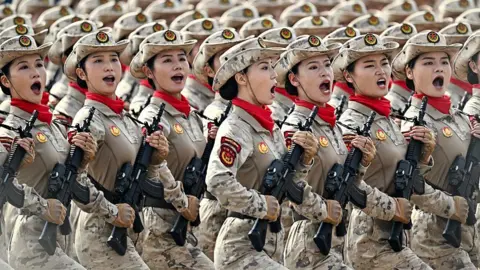China has unveiled a range of new weapons, drones, and other military hardware in a massive parade that many see as a clear message to the United States and its allies.
The event saw Xi Jinping host more than 20 foreign heads of state, including Russia's Vladimir Putin and North Korea's Kim Jong Un, both of whom rely on China for economic support and more.
It was a display of Xi's growing power on the world stage and of China's military prowess - the show included the 'Guam killer' missile, the 'loyal wingman' drone, and even robotic wolves.
Here are our five takeaways:
1. China has a lot of weapons. How well can it deploy them?
What was clear from Wednesday's display was that China has been able to quickly produce a diverse range of weapons.
Ten years ago, the military technology they put on show tended to be 'rudimentary copies' of far more advanced equipment invented by the US, notes Michael Raska, assistant professor in the military transformations programme at the Nanyang Technological University of Singapore.
But this parade revealed a more innovative and diverse range of weapons, particularly drones and missiles - a reflection of how advanced their defense-industrial complex has become.
China's top-down structure and significant resources enable it to churn out new weapons faster than many other countries, points out Alexander Neill, an adjunct fellow with the Pacific Forum. It can also produce them in huge quantities, giving it a battlefield advantage.
But how well can China's military integrate these weapons systems? 'They can show off these flashy advanced platforms, but are they organizationally agile to use them in the way they want to?' Dr. Raska asks.
He adds that it won't be easy because the Chinese military is massive and untested, given it has not been involved in a significant war for decades.
2. China is focusing on missiles to counter the US
China has rolled out plenty of missiles, including some new variants. These include the Dongfeng-61, capable of carrying multiple warheads in its nosecone; the Dongfeng-5C intercontinental ballistic missile which could be launched from northern China and hit the US; and the 'Guam Killer' Dongfeng-26D missile, which could hit key US military bases in Guam.
There were also several hypersonic anti-ship missiles such as the YJ-17 and YJ-19, which can fly very fast and maneuver unpredictably to evade anti-missile systems.
There's a reason for this focus on missiles. China has been developing missile forces as a key part of its deterrence strategy to counter the US' naval superiority, Mr. Neill says.
Beijing is not only strengthening deterrence but is also creating a 'second strike capability,' a country's ability to launch a retaliatory strike if attacked.
3. China is going all the way with AI and drones
China showcased a variety of drones, some equipped with artificial intelligence, including the AJX-002, a giant submarine drone aimed for surveillance and reconnaissance missions.
The GJ-11 stealth attack drone, dubbed the 'loyal wingman', can fly alongside manned fighter jets enhancing their effectiveness in battles.
Experts indicate that the use of drones aligns with lessons from the Ukraine war, focusing on rapidly overwhelming defenses with drone attacks.
4. China may have the technology, but the US still has an edge
The parade demonstrates that China is catching up quickly with the US in military technology, maintaining a large arsenal of weapons; however, the US still excels in operational efficiency due to a more adaptable 'bottom-up' culture.
5. The parade was a weapons sales pitch – and a chance to show the US a united front
The celebration not only served as a showcase for military might but was also a strategic play to appeal to potential international buyers of Chinese arms.
Among the key clients present were Vladimir Putin and Kim Jong Un, reinforcing a united front against US opposition.






















